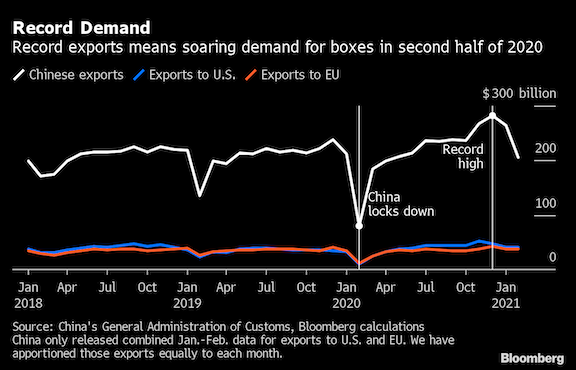The world’s biggest makers of shipping containers are scrambling to meet a surge in demand for the metal boxes that shuttle some 90% of the goods around the global economy.
A trade boom in the second half of last year caught the container producers—mostly Chinese companies—by surprise as the pandemic threw the existing supply of about 25 million boxes off their normal routes. The manufacturers have been ramping up output ever since, but they’re unable to alleviate shortages that have underpinned soaring freight rates for six months.

“There should be enough boxes to cope with the level of demand in normal conditions,” according to Simon Heaney, senior manager of container research at Drewry Shipping Consultants Ltd. “The problem is that box usage has extended because of all of the delays, meaning its takes longer to release units back to the next customer.”
On The Backfoot
The container manufacturing industry didn’t enter 2020 in a good position, with production and sales in China dropping in 2019, according to a written interview with China International Marine Containers Co., the world’s-largest manufacturer.
There was also a huge surplus of boxes, with the equivalent of more than 3 million empty 20-foot containers at Chinese ports at the end of March last year and 1.2 million in storage at container manufacturers, Li Muyuan, vice president of the China Container Industry Association, said in an interview with Chinese media earlier this year.
That surplus, combined with the expectation that trade would collapse as Covid-19 spread globally, caused a slump in orders to Chinese container manufacturers, which account for more than 90% of the world’s supply. There were almost no new orders for the industry in the first five months of 2020, CIMC said Thursday in their emailed response to questions.
However, the situation reversed around mid-year, as consumers in the U.S. and elsewhere binged on computers and equipment to work at home or decorate their houses, and imports of masks and other pandemic-related goods soared.
Rising exports from China then led to a flood of orders for new containers, in some cases doubling the price to more than $3,000 for a standard 20-foot box. CIMC said it has added 5,000 workers since September last year and even ran some production lines through the Lunar New Year holiday last month.
Output Rises
Production rose to 300,000 20-foot equivalent units in September, then to 440,000 in January, according to Li.
But that’s not been enough to make up for the fact that there aren’t enough used boxes being returned from overseas to China to be refilled and re-exported.
Ocean carriers that own or lease most of the containers in use are aggressively trying to get boxes back to Asia from the U.S., according to Ken Hoexter, a transportation industry analyst at Bank of America in New York. But the current tightness in transportation markets will continue at least through the middle of the year or later, he said in an interview last week.
The shipping industry is trying to play catchup but the combination of extremely low inventories, port congestion in the U.S., increasing consumer demand, the lack of any downtime in China during the curtailed Lunar New Year and now the Biden administration’s $1.9 trillion stimulus package will extend the shortages, he said.
Even with rising output of new containers, the situation won’t get better until June when vaccine rollouts will ease the pandemic and boxes start coming back to China, Mai Boliang, CEO and chairman of CIMC, told Chinese state TV in early March.
“As we progressively move out of the Covid economy towards the end of the year we’re going to see a normalization of trade in containers,” said Olivier Ghesquiere, president and chief executive office of box-leasing firm Textainer Group Holdings Ltd. “But we are not going to see a situation where there’s an excess of containers in the market,” he said on a recent earnings call, noting that production capacity is virtually sold out for the first half of this year.
That means high freight rates—the most visible sign of the shortage of steel containers—could continue for some time.










